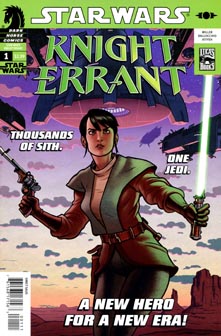“Knight Errant” (2010-12), John Jackson Miller’s second “Star Wars” saga after “Knights of the Old Republic,” has one of the darkest possible premises: Lone Jedi Knight Kerra Holt tries to gather up slaves from Sith territory to bring to Republic space as refugees. This is a time – one generation before the “Darth Bane” novels — when the Sith are so dominant in one part of the galaxy that the Republic gives up on it, even shutting down communications relays. Kerra’s mission is not to win, but simply to save lives.
Yet from the pen of Miller – who also brought a level of lightness to “KOTOR” that contrasted with “Tales of the Jedi,” set just before that – the three five-issue volumes of “Knight Errant” (along with the novel) are a lot of fun. Although these are life-or-death stories, a reader gets a curious sense of glee from reading about the Sith wars, particularly the two warring villains, the brothers Daiman and Odion.
Daiman, blond and handsome, believes he created the universe; Odion, scarred and ugly, believes death is the only thing with meaning. Miller does such a nice job characterizing them that it doesn’t matter how ridiculous these characters are on the surface. Both are entirely self-aware. As Daiman tells Kerra in the first volume, “Aflame”:
“Self-glorification is central to Sith belief, Jedi. I practice its logical end – a Sith solipsism that understands my place in the cosmos – AS the cosmos. The thing you call reality might well be just a Force vision to test me. I’m not convinced that you exist.”
It’s too bad that we don’t get a fuller backstory about how Daiman came upon the string of logic that led to his worldview, but we do get that for Odion, who began to get headaches when his brother was born. As Odion explains in “Escape,” the third volume:
“As my Force talents grew, I became hypersensitive to the mere existence of others. It was debilitating. No one could help. Hiding didn’t work. In the end, there was only one solution – a Sith solution. I learned I could strike out against the pain – by snuffing out the bright lights in my mind, one by one. Every death provided relief.”
For her part, Kerra has the classic Force-user origin story of being orphaned (or so it seems; the mystery of her parents’ fate will play into “Escape”) but taken in by the Jedi. Her arc isn’t about developing a desire to fight for what’s right – that’s baked into her; it’s more about accepting that other people are held back by their attachments.
As she attempts to rescue refugees from Aquilaris who don’t want to be rescued in “Deluge,” the second volume, we see an example of Kerra’s common complaint: “Blast it – why does it always have to be this hard? Why do I always have to do everything myself? Just once, I’d like to meet some people with some fight!”

Rather than trying to get others to reject attachment, an approach that some might say fits with Jedi philosophy, she herself embraces more attachments. She widens her view of “family” to include all innocent beings. In the final pages of “Escape,” an ally flies off with a ship full of refugees, and she says with a smile: “That’s my family you’re carrying.”
Fans who were thrilled to see a female protagonist on the big screen — Rey in “The Force Awakens” – will see a lot of similarities in Kerra, someone whose heroism comes naturally but who could use a nudge in the right direction and who could stand to forgive others’ flaws.
Miller is a master at creating complex war plots that make sense from the perspectives of the people carrying them out, but having everything come back to character insight. “Deluge” is my favorite of the three volumes, largely because of Jenn Devaad, who at first seems to be a Republic-linked relief worker who shares Kerra’s philosophy. But she’s so attached to her own squadron that she sacrifices the wider mission. Additionally, Zodoh the Hutt – a rare Hutt who enjoys doing the dirty work himself – makes for a great rival to Jenn and Kerra.
Dark humor is probably inevitable in stories set in Sith space – for example, Odion creatively dispatches Zodoh by using a moisture vaporator to freeze-dry the Hutt – but Miller also sometimes slows down the action for some snort-worthy non sequiturs.
For example, in “Aflame,” when Odion acquires a Magneto-esque ancient Sith helmet that will supposedly amplify his power, he says: “But the one thing history didn’t warn me about – is how small Ieldis’s head was! I feel like I’m stuck in a trash compactor!”
“Knight Errant” ended after 15 issues as Miller turned his focus to his third saga, “The Lost Tribe of the Sith.” Thanks to Disney’s cancellation of the EU, we’ll never know if Dark Horse would’ve returned to Kerra’s adventures. But interestingly, “Knight Errant” would’ve been almost impossible to end with a happy victory for the good guys. In the “Darth Bane” books set a few decades after “Knight Errant,” the Sith still dominate this region of the galaxy; Bane moves to end the infighting and consolidate their power with the Rule of Two.
It’s possible that Miller never intended to give this saga a traditional ending. Each volume of “Knight Errant” closes with the phrase “And the fight goes on …” Similar to Fox Mulder in “The X-Files,” Kerra faces such long odds and has so few allies that she can’t win, but she can score small victories, and that’s more than enough to live for.

